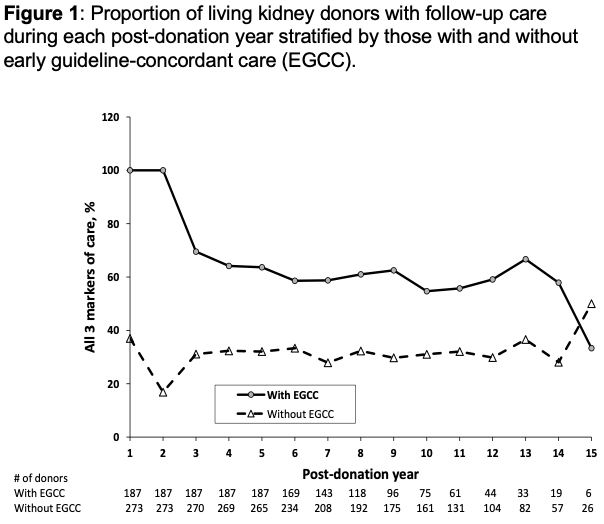Long-Term Outcomes for Living Kidney Donors with Early Guideline-Concordant Follow-Up Care
1Department of Medicine, Division of Nephrology, University of Calgary, Calgary, AB, Canada, 2Department of Medicine, Division of Nephrology, University of Alberta, Edmonton, AB, Canada, 3Center for Abdominal Transplantation, Saint Louis University, St. Louis, MO, 4Department of Medicine, Division of Nephrology, Western University, London, ON, Canada
Meeting: 2022 American Transplant Congress
Abstract number: 102
Keywords: Donation, Glomerular filtration rate (GFR), Monitoring
Topic: Clinical Science » Kidney » 39 - Kidney Living Donor: Long Term Outcomes
Session Information
Session Name: Kidney Living Donor: Long Term Outcomes
Session Type: Rapid Fire Oral Abstract
Date: Sunday, June 5, 2022
Session Time: 5:30pm-7:00pm
 Presentation Time: 6:40pm-6:50pm
Presentation Time: 6:40pm-6:50pm
Location: Hynes Room 206
*Purpose: Current guidelines recommend that living kidney donors receive annual lifelong follow-up to monitor kidney health. It is unclear whether early guideline-concordant care is associated with improved subsequent follow-up and clinical outcomes.
*Methods: We conducted a retrospective, population-based cohort study using linked healthcare databases in Alberta, Canada to study follow-up care and outcomes of living kidney donors who underwent nephrectomy between 2002 and 2013. We compared donors with and without early guideline-concordant care, defined as annual physician visit, serum creatinine, and albuminuria measurement for the first two years post-donation. The primary outcome was evidence of continued annual follow-up at 5 and 10 years (adjusted odds ratio with lower and upper confidence limits, LCLaORUCL). Secondary outcomes included mean change in estimated glomerular filtration rate over time (LCLeGFRUCL) and rates of all-cause hospitalization (adjusted rate ratio, LCLaRRUCL).
*Results: Our study included 460 living kidney donors, of whom 187 (41%) had early guideline-concordant care. Over a median follow-up period of 10.7 years, the odds of having annual follow-up for donors without early guideline-concordant care were 76% lower at 5 years (aOR 0.180.240.32) and 68% lower at 10 years (aOR 0.230.320.46) compared to donors with early care. The odds of continuing follow-up remained stable over time for both groups. From 2.5 years post-donation onwards, the eGFR increased slightly over time for donors with early follow-up care (0.090.340.58 mL/min/1.73m2 per year) and without early follow-up care (-0.030.200.42 mL/min/1.73m2 per year), although the latter was not statistically significant. Hospitalization rates were similar between the two groups (aRR 0.771.191.84).
*Conclusions: Early guideline-concordant follow-up care is associated with improved subsequent follow-up but does not have a meaningful impact on eGFR or hospitalization rates. Therefore, mandating early follow-up could serve as a useful policy to encourage continued follow-up, but may not sufficiently mitigate long-term risks.
To cite this abstract in AMA style:
Dhalla A, Lloyd A, Lentine KL, Garg AX, Quinn RR, Ravani P, Klarenbach SW, Hemmelgarn BR, Ibelo U, Lam NN. Long-Term Outcomes for Living Kidney Donors with Early Guideline-Concordant Follow-Up Care [abstract]. Am J Transplant. 2022; 22 (suppl 3). https://atcmeetingabstracts.com/abstract/long-term-outcomes-for-living-kidney-donors-with-early-guideline-concordant-follow-up-care/. Accessed January 8, 2026.« Back to 2022 American Transplant Congress

